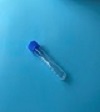
Thrombospondin Type-1 Domain-Containing 7A Antibodies, Serum-994
Test info
THSD7A
THSD7A Ab, S
Thrombospondin
Distinguishing primary from secondary membranous nephropathy cases with antibodies against THSD7A
Specimen
Immediately following collection, mix sample by gently inverting 5 times
- Allow sample to clot for a minimum of 30 minutes
- Spin
Immediately following collection, mix sample by gently inverting 5 times
- Allow sample to clot
- Spin
- Transfer the serum to a Screw cap transfer vial/tube (Mayo T914), labelled as serum
- Refrigerate
Refrigerated (preferred) - 14 days
Ambient - 8 hours
Frozen - 14 days
Gross hemolysis
Performance
Indirect Immunofluorescence Assay (IFA)
Clinical and Interpretive info
Negative
Recently, autoantibodies against phospholipase A2 receptor (PLA2R) in the kidney were determined to be the major target antigen for patients with idiopathic/primary membranous nephropathy (MN). Approximately 70% of patients with primary MN circulate anti-PLA2R antibodies, and in the remaining 30% (who are PLA2R-negative), anti-thrombospondin type-1 domain-containing 7A (THSD7A) was shown to have approximately a 10% prevalence (or about 3% of all primary MN patients). Mouse podocytes express THSD7A and introduction of anti-THSD7A autoantibodies induces MN in murine models. Mouse podocytes do not express PLA2R so exogenous administration of anti-PLA2R does not recapitulate membranous nephropathy in mice. Additionally, THSD7A has been described as a potential tumor antigen and, thus, it has been suggested that THSD7A-positive patients merit a thorough cancer screening.
Absence of circulating autoantibodies does not rule out a diagnosis of primary MN.


